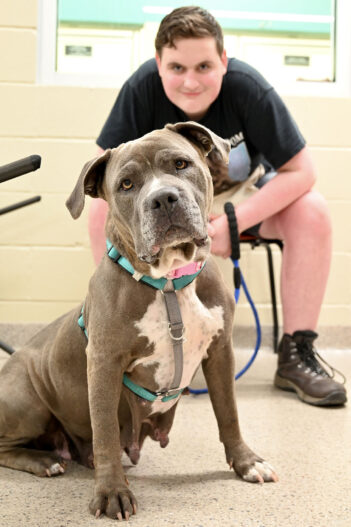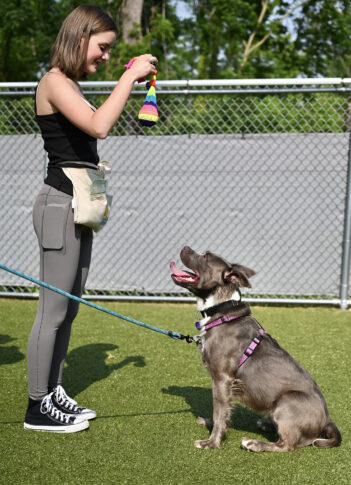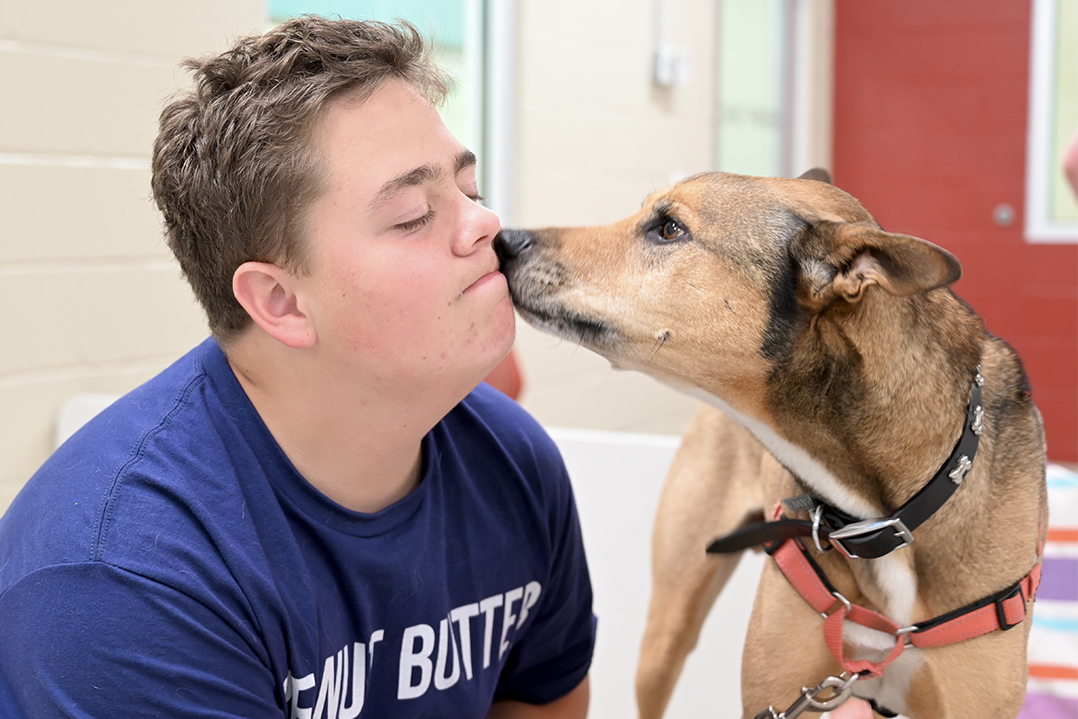In a large room next to the dog kennels at the Humane Society for Hamilton County’s facility in Fishers, about a half-dozen very happy shelter dogs get to spend some time outside of their kennels and interact with young people.
Kids and dogs working together — it’s a great combination of energy and enthusiasm, leading to positive results for members of both species. That’s the goal of the youth-canine program, led by Indianapolis-based nonprofit Paws & Think.

Ashleigh Coster is executive director of Paws & Think. She said the program brings young people into the shelter to connect with dogs that need a little training.
“The idea is that at the end of the one-week program, the dogs are more adoptable because they know their commands a little bit more,” she said. “But it’s also a chance to connect with young people and give them an opportunity to have a unique connection.”
Coster said many of the youths in the program face challenges, such as anxiety or depression. They partner not only with the shelter, but with the Fishers Youth Assistance Program to find kids and dogs who will benefit most from the interaction.
“Essentially, it’s a weeklong program,” she said. “Youth are here every day for about an hour. They are learning positive-reinforcement training techniques to help the dogs learn a lot of basic commands. The whole goal of the program is, one, for young people to connect and have a unique human-animal connection, but also to help make sure that the dogs are more adoptable towards the end of the week.”
A new week leads to a new set of kids and dogs.
The kids work with adult coaches who understand positive-reinforcement training, and help the young trainers learn how to teach the dogs.
“They’re able to help redirect as needed. They’re there for, obviously, safety measures as well,” Coster said. “But they can really help the young people that may be struggling teaching a certain command — they can help them with different ideas on ways to maybe get connected to that dog in a different way.”
And in the process, everyone is having a lot of fun. The kids get all the unconditional love that dogs can give — plus plenty of dog kisses — and the dogs get attention, interaction and activity that helps alleviate the boredom of shelter life.
Lilly Pesavento is the community engagement manager for Humane Society for Hamilton County. She said the youth-canine program is a fantastic opportunity for the shelter dogs.
“When you think about it, these are dogs that are kept in a cage day in and day out, people walking by them all the time,” she said. “This is an opportunity for them to feel wanted, for them to feel loved, for them to feel like they have a purpose, because so many of these dogs, they just want to learn. They just want that human connection.”
Learning basic commands does make them more adoptable, she said, but the program also gives them a purpose while they’re in the shelter waiting for a new home. Pesavento said the shelter selects dogs for the program that are friendly with kids, men and women, and have been in the shelter the longest.
“Right now, we have two pit bulls that are in the program, and pit bulls are very hard to get adopted,” she said. “That’s very unfortunate because of the stigma of their breed. So this is also teaching young people to that pit bulls are nothing to be afraid of. They’re not scary dogs, they’re not violent dogs, they can be trained, they’re very smart, they’re very attentive, they’re very gentle, and that’s a great part of the program is showing them this side of pit bulls.”

One of the pitfall mixes, Radio, was very happily learning new tricks from youth trainer Hannah Bachmann. She said she has an akita at home, and that’s another breed that people stigmatize.
“A lot of people see her, and they cross to the other side of the street,” Bachmann said. “And it makes us really sad because she’s such a sweetheart, and she loves other people. And I don’t want these shelter dogs to have the same experience that my dog has. I don’t want these shelter dogs to have people cross the street when they see them walking by.”
Bachmann, a senior at Hamilton Southeastern High School, said she also picked up new skills through the program. She’s learned to be more patient with dogs, how to not reward bad behaviors, and more about dog body language.
Coster said Paws & Think also hosts “Pawsitive Corrections,” a similar program that brings shelter dogs to the Marion County Juvenile Detention Center for a week of training and connections with disadvantaged youth.
For more about Paws & Think, visit pawsandthink.org. To see adoptable pets at the Humane Society for Hamilton County, visit hamiltonhumane.com.
Positive reinforcement training techniques
Positive reinforcement is a dog-training method that uses rewards — such as treats, a favorite toy or praise — to encourage desired behaviors.
According to the Humane Society of the United States website, correct timing is essential for effective positive reinforcement training.
“The reward must occur immediately (within seconds) of the desired behavior, or your pet may not associate it with the proper action,” the website states. “For example, if you have your dog sit but reward them after they’ve stood back up, they’ll think they’re being rewarded for standing.”
Verbal commands need to be short and uncomplicated.
“In fact, dogs learn first from our body language, so first work on encouraging your dog into a ‘sit’ or ‘down’ before asking them with a word,” according to the website. “Holding a toy or treat, slowly move your hand over and slightly behind your dog’s head so that they have to sit to look up and view it. When your dog is sitting, you can lure them into a down position by slowly lowering your hand and bringing the reward close to the ground between their front paws. Once your dog is performing the behavior consistently, start adding the word ‘sit’ or ‘down’ in a calm voice and try not to repeat the word.”
Once a dog has learned a behavior, you can slowly wean them off the treat reward until they perform the behavior without a treat.
The website notes that consistency is important, so everyone in a household should use the same commands when training a dog. Treats for training should be tempting, small — about the size of a pea — and easy for the dog to eat quickly. If a dog isn’t treat-motivated, rewards can be a favorite toy, praise or playtime.





